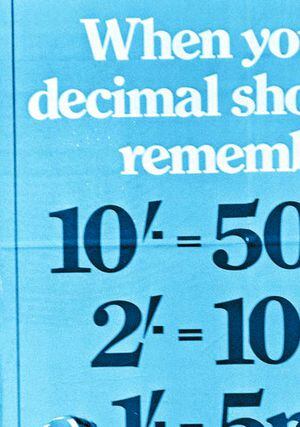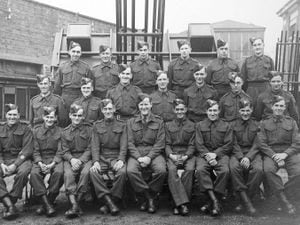Half a century since the day decimalisation reached Britain
It never pays to rush into things, especially where money is concerned.

Fifty years ago today, Britain finally made the switch to decimal currency, and the people of the West Midlands seemed decidedly unimpressed.
Even the youngsters had their concerns.
"I'm trying hard, and I hope it's going to be all right, although I must confess I'm a bit worried," said 21-year-old Kristina Thorpe, from Shrewsbury.
"It's a bit of a nuisance," added 19-year-old shoe-shop assistant Glenys Powell.
Young mother Muriel Pritchard thought it would be used as an excuse to put up prices.
"I know that in Wolverhampton they have been putting on the odd penny and tuppence," she said. "I'm trying to think in decimals, but I'm carrying my shopper's tables with me to make sure I don't get diddled."
People had good reason to be sceptical. Spending a penny was clearly going to be more expensive than before, and the decision by the region's two main brewers to put a penny on the price of a pint also left a bitter taste in the mouth.
Granny Gets The Point, a short film where a grandmother stubbornly refuses to listen as her grandson tries to explain the new system, managed to patronise viewers in the way that only public information broadcasts can. And if that wasn't bad enough, Max Bygraves was commissioned to record an excruciating song called 'Decimalisation', which only served to demonstrate why governments and popular culture should never be allowed to mix.
Still, 15-year-old Sandra Martin was more optimistic: "I think after a while everybody will get the hang of it," she said.
And while some of the public relations was ham-fisted, people could hardly complain they hadn't been given fair warning. This was a change that had been brewing for nearly 150 years.
And it was a man from this neck of the woods who started it.
Sir John Wrottesley, who lived in Perton, near Wolverhampton, first proposed the idea in 1824. Sir John, who was MP for Staffordshire, had been impressed by the simplicity of the French Franc, and thought a similar system could be introduced here. The Decimal Association was founded in 1841 to encourage the change, and the first tentative step came in 1849, with the introduction of the silver florin, worth 24d, or one-tenth of a pound. The logical next step would be divide the florin into 10 pennies, but it was going to take a while...
Russia had been the first country in Europe to embrace decimal money in 1704, when Peter the Great introduced the silver rouble, equivalent to 100 copper kopeks, although the Chinese had been using a similar system for about 2,000 years. The United States followed suit in 1792, basing its currency loosely on the Spanish dollar, and the 19th century saw a number of countries across mainland Europe make the switch.
Yet for some reason, the idea of decimalisation remained resolutely unpopular in Britain. In 1961, then prime minister Harold Macmillan set up a committee headed by respected academic Lord Halsbury to examine the different options.
One option was to follow the Australian model, which had introduced a dollar valued at ten old shillings, which would then be divided into 10 rather than 12 pence, meaning only a small change to the value of a penny. Wrottesley's 'pound and mill' system, which would see the pound divided into 1,000 mills, which would effectively replacing the old farthing. Another was to create a new pound, valued at 100d.
However, when Halsbury presented his report in 1963, he decided that the pound’s value as a reserve currency on the international money markets was too important to tamper with. Instead, he opted for a system which effectively retained the pound, florin and shilling in their existing form, but revalued the penny so that there were now 100p to a pound, 10p to a florin and 5p to a shilling. By this time, rising inflation meant copper coins were becoming less important, so revaluing the penny had less of an impact on the economy.
Yet the decision to go decimal, which followed 140 years of agonising about its pros and cons, was actually made in seconds on the whim of a prime minister. By this time, the youthful Harold Wilson had been elected on a pledge to reshape Britain in the 'White heat of revolution', and the new PM was keen to be associated with anything modern and progressive.
Economist Peter Jay, whose father-in-law Jim Callaghan was Chancellor of the Exchequer, recalls Callaghan briefly calling in next door to discuss the matter with the Prime Minister.
"They talked for about 20 seconds and Wilson said 'well why not?' and that is how the decision was made," he says. "In a few seconds a century and half of argument about decimalisation came to an end."
The decision was announced to Parliament in 1966, and it was decided that the system would be phased in over a number of years, to give people time to adjust.
The first decimal coins, the 5p and 10p, were introduced in April 1968. The Royal Mint deliberately ensured that the new coins were all but identical to the existing shilling and florin, only with the inscriptions 'five new pence' and 'ten new new pence'. They had exactly the same value as the old coins, and once the novelty wore off they were pretty much treated as such, with shops still pricing their items in pounds, shillings and pence. But when the old ten-bob note was replaced by the 50p coin the following year, the reaction was much more hostile. The first seven-sided coin in the world, the change was too much for some people, with one newspaper headline describing it as 'a monstrous piece of metal'. A retired colonel even launched an anti-heptagonist movement, but there was yet more to come.
Dubbed 'D-Day' by the media, February 15, 1971 saw the launch of the new 1p and 2p coins, and the official switchover to decimal pricing. Many businesses, this newspaper included, had already launched a dual-pricing system at the start of the year, where prices were marked in both old and new pence to get people used to the new system. This continued for some time, and old pennies remained in circulation for a further 18 months. To help deal with problems caused by 'rounding up' prices, a new halfpenny coin was introduced on a temporary basis. Not to be confused with the old halfpenny, which had been dropped two years earlier, the tiny new coin effectively replaced the old penny.
It would be a while before we saw the end of the old silver coins, though. The sixpence – valued at two-and-a-half new pence – remained in circulation until 1980, and the shilling and florin would last to see the 1990s. The florin, in fact, remained in use until 1993, some 22 years after 'D-Day' – and nine years after the unloved new halfpenny was withdrawn from circulation.
Of course, by the early 1970s, coin-operated machines were becoming increasingly commonplace, and both public utilities and private companies faced the mammoth task of adapting thousands of phone boxes, vending machines and parking meters.
Many mourned the passing of the old coins. The commentator Dominic Sandbrook described D-Day as the day 'we lost a little bit of our national soul'. But while new pence will never have the romance of the tanner or the half-crown, even the most dyed-in-the-wool traditionalist would surely acknowledge that decimalisation has made life a lot easier.
Besides, the years that followed saw Britain join the Common Market, and with it the compulsory adoption of metric measurements. And that was something that people would really get wound up about...





